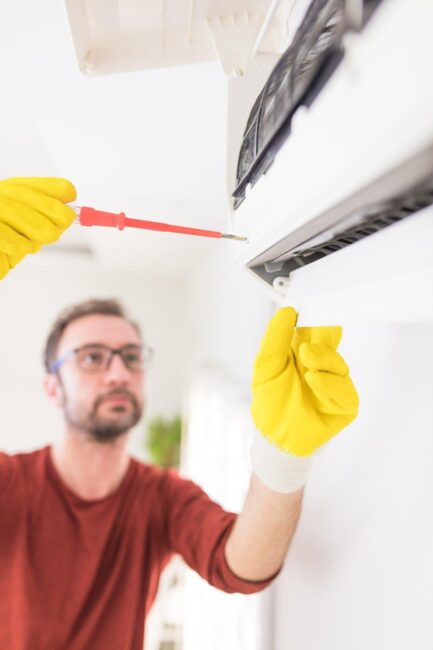
A well-controlled interior temperature provides comfort for restless evenings and sweltering afternoons. While smart thermostats provide dynamic management, cooling systems still require hands-on maintenance to function at optimal efficiency. Combining modern sensors with scheduled maintenance reveals latent inefficiencies and helps to control energy use. Using planned repairs and data-driven insights turns a basic AC into a flawless friend against the most intense heat of summer.
Leveraging Adaptive Learning Features to Fine-Tune Cooling Cycles
Adaptive learning algorithms in smart thermostats examine daily habits and local weather variations to create very effective cooling programs. These appliances track temperature preferences, humidity fluctuations, and occupancy patterns to pre-chill living areas immediately before maximum heat hits. The technology reduces compressor stress and eliminates unnecessary running by automatically changing setpoints during unoccupied times. Including utility rate schedules in thermostat programming helps to save money by moving significant cooling demands to off-peak times. Reducing brief cycling and guaranteeing consistent comfort, these sophisticated controllers continuously improve operation depending on the result data far more than basic timers. Reviewing learning summaries on a regular basis exposes areas that can indicate underlying AC problems needing professional attention for appropriate AC repair service. It also indicates areas for hand adjustments.
Diagnosing System Health Through Thermostat-Generated Performance Metrics
Designed as a diagnostic window into the core of any cooling system, smart thermostats gather comprehensive runtime data and cycle counts. In moderate weather or regular short cycles, spikes in runtime frequently indicate blocked filters, blocked coils, or refrigerant depletion. Long recovery periods following temperature drops point to compressor inefficiencies or airflow constraints. Over several days, indoor-outdoor temperature differences assist in identifying duct leaks and wasting cold air. Many smart models show error codes sent from the HVAC control board, directly indicating electrical issues or sensor misreads. Sharing these metrics with service experts speeds up troubleshooting and substitutes-focused fixes for guessing. Tracking performance patterns between seasonal tune-ups helps preventative maintenance become a proactive, statistically supported tool.
Maximizing Remote Alerts and Automated Maintenance Reminders
Smart thermostats’ immediate alerts enable quick solutions before little problems turn into serious breakdowns. Low-battery alerts stop sensor failures that throw off temperature control and overdrive the compressor. Designed to sustain airflow and promote indoor air quality, filter-change reminders are set according to real pressure drop data. Alerts for very high or low humidity levels—above or below defined thresholds—highlight possible condensation problems, encouraging coil frost or mold growth. Customizable push notifications for system failures—open-circuit sensors or communication faults—help to reduce ongoing downtime. Combining these alarms with a unified home automation dashboard streamlines all home health data. Adopting automated maintenance calls maintains preventative activities first and helps to turn irregular service inspections into a disciplined maintenance schedule.
Integrating Zoning Controls with Smart Thermostat Capabilities
Separating a house into several climatic zones increases the advantages of one smart thermostat by allowing separate temperature management across several living spaces. Reacting to thermostat signals, motorized dampers in ductwork route conditioned air solely to occupied areas and help to avoid energy waste in empty rooms. By matching airflow depending on localized temperature sensors, zoning removes hot and cold areas. Combining each zone with a wireless sensor network lets the system give comfort top priority where it most counts. Fine-tuning zone schedules enables unique cooling profiles—diminished air supply in infrequently used guest rooms and increased circulation in busy living areas. Through the avoidance of needless full-house operation, this synergy between zoning hardware and intelligent control maximizes system efficiency and extends equipment lifetime.
Coordinating Professional Repairs with Smart Insights for Precision
By providing specific proof of system failures and consumption trends, smart thermostat data simplifies technician visits. Energy-use statistics, fault code logs, and detailed runtime charts give service personnel a clear starting point that reduces diagnosis time. Technicians arrive ready with the correct replacement components and tools to do repairs quickly and precisely. By means of live data streams, sharing remote system access lets specialists check restored functioning even before leaving the house. Certain service plans incorporate thermostat integration, which gives providers continuous system health insight and supports predictive maintenance plans grounded on actual operation. Homeowners, thermostats, and technicians working at this degree of cooperation create a precision-driven service model that keeps cooling systems running with little downtime.
Ensuring Firmware Updates and Network Security to Protect System Integrity
To fix vulnerabilities, improve feature sets, and keep compatibility with changing HVAC controls, smart thermostats depend on frequent firmware upgrades. Quickly installing updates helps to stop attacks that may compromise home networks or provide illegal access to temperature controls. Strong password systems, secure Wi-Fi setups, and two-factor authentication help to guard against unwelcome access. Further posing hazards and safeguarding sensitive data is isolating thermostats on specialized IoT networks. Examining update notes helps one to identify new diagnostic tools or performance improvements that directly improve AC efficiency.
Conclusion
Using smart thermostat intelligence in concert with timely expert maintenance produces unparalleled cooling performance. Protecting system integrity calls for securing firmware and networks. This all-encompassing strategy turns conventional air conditioning into a responsive, robust climate solution fit for the most demanding summer.
